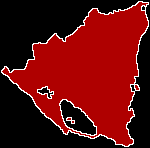

1997, april 14 - 18 - sandinistas lead 5 day national strike
sandinista unions in nicaragua began a national strike to protest the government's economic policies. sandinista leader and former president, daniel ortega, sounded a serious note when he told the media: "if we let the government continue applying its dictatorial project (of economic austerity) there will be no alternative but to take up arms once again to end the dictatorship,"
more than 50 roadblocks made sure that traffic in the capital, managua, was paralyzed. thousands of protesters marched to the country's national assembly. there were no reports of violence during the duration of the strike.
at the end of the strike, ortega announced an agreement with the government which would "allow an opportunity for understanding" and said a national dialogue would begin on april 21.
from solinet's archive of labor news
1993, september 20 - 24 - government responds to strike with violence but ultimately backs down
in the three years since the u.s.-backed violeta chamorro administration ousted the sandinistas from power, chamorro had tried to turn back the gains of the sandinista revolution and the ensuing 10 years of progress. her government had stopped agrarian reform, broken unions and brought down wages, raised prices and cut back on social programs. poverty, unemployment and homelessness were at an all-time high. water supplies were low and disease was claiming many lives.
the general strike started september 20, when transport workers blocked streets and bus depots with rocks and tires. they went out on strike to protest hikes in vehicle taxes and fuel prices imposed by the president. the strike paralyzed activity as businesses and offices closed in all of nicaragua's major cities. many workers, without transportation, stayed home. two days into the strike, managua radio station la primerisima called on the sandinistas to "take charge of the government" and oust president violeta chamorro.
the second day of the strike was a tragic milestone. the strike had spread throughout the country. facing a possible uprising, president chamorro flew to guatemala. in order to clear a passage for her expected return to the country that evening, police were ordered to disperse protesters on the highway leading to the airport and to demolish the barricades. in a televised offensive, police fired on protesters who responded with rifles and home-made mortars, two people were killed and five others received bullet wounds. saul alvarez, 37, deputy head of the police security branch, and rosmelda martinez, 41, a bystander who had just arrived from the caribbean coast, both died of bullet wounds.
sandinista leader and former president daniel ortega called for police to disobey their superiors when ordered to repress strikers and made a plea to the public for solidarity with "our companeros in the police force, who, risking their lives for $80 a month, are also victims. the police force is not our enemy," he pointed out (the dead police officer was in fact a long-standing sandinista militant). "the repressive attitude of the government is our enemy, the government's economic policy is our enemy."
on september 24, transport workers and their supporters celebrated a historic victory. after 38 hours of continuous negotiations, the government finally conceded to the bulk of the strikers' demands, including the annulment of the vehicle ownership tax.
from the new york transfer news collective
more info is available from a series of e-mail reports from ed brown's political economy archive.
the world : central america and the caribbean : nicaragua
figgins@dnai.com